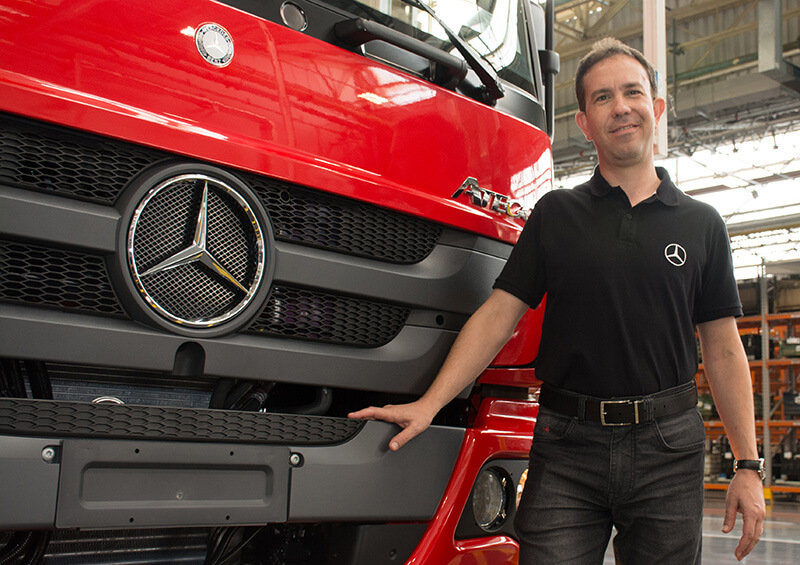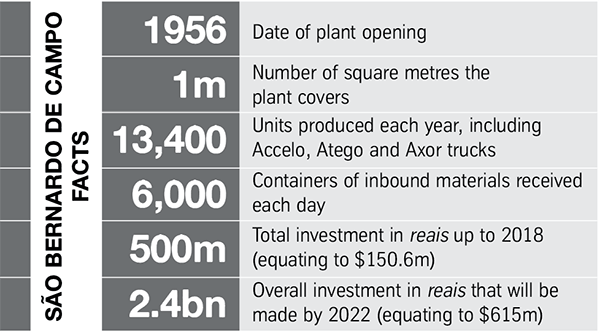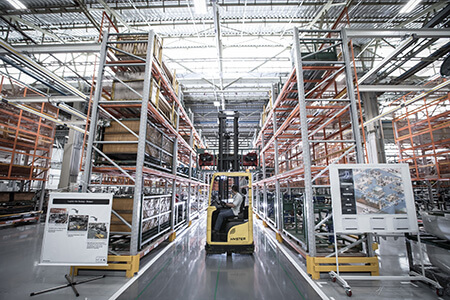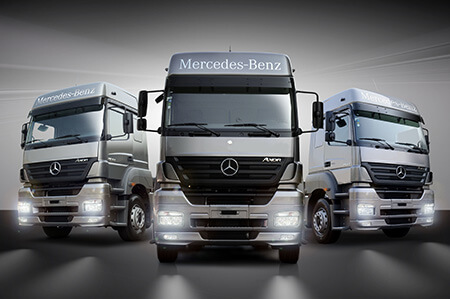 Daimler Trucks’ division in Brazil – Mercedes-Benz do Brasil – has invested 500m reais ($150.6m) in its 1m sq.m plant in São Bernardo do Campo, São Paulo state, to establish a new truck assembly line and transform its supporting inbound logistics structure. The comprehensive overhaul of operations is part of a wider 2.4 billion reais investment project in the commercial vehicle-maker’s facilities in Brazil, which will run to 2022. It includes implementation of the latest digital technology and automation that has resulted in a 15% improvement in assembly line efficiency and a reduction in the number of parts stores from 53 to just six. Storage time for components has been reduced from 10 days to three.
Daimler Trucks’ division in Brazil – Mercedes-Benz do Brasil – has invested 500m reais ($150.6m) in its 1m sq.m plant in São Bernardo do Campo, São Paulo state, to establish a new truck assembly line and transform its supporting inbound logistics structure. The comprehensive overhaul of operations is part of a wider 2.4 billion reais investment project in the commercial vehicle-maker’s facilities in Brazil, which will run to 2022. It includes implementation of the latest digital technology and automation that has resulted in a 15% improvement in assembly line efficiency and a reduction in the number of parts stores from 53 to just six. Storage time for components has been reduced from 10 days to three.
Carlos Santiago (pictured above), chief operations officer at Mercedes-Benz do Brasil, explains that compared with the old assembly line, from which the truckmaker has been transitioning over the last three years, the new one has enabled a 15% improvement in the standard time for assembly per truck. The São Bernardo do Campo plant makes the Accelo, Atego and Axor trucks in a range of model options. That saving in assembly line efficiency is reflected in the cost, and comes at a time when the truckmaker is building up production, following a tough economic downturn between 2013 and 2017.
On top of its improvement in assembly time and cost per unit, Mercedes-Benz do Brasil has achieved a 20% reduction in total logistics costs for inbound parts from their point of entry into the facility (though the company would not reveal the absolute figure). That has been achieved by a range of measures, including more efficient deployment of workers, a much smaller number of larger storage hubs, reduced expenditure on forklifts and tugger trains, and efficiency gained through industry 4.0 technology.
 Operatives are now using smart apps and assembly station interfaces, the plant has introduced 60 automated guided vehicles (AGVs) for assembly line delivery, and the company is analysing a huge amount of data gathered from connected devices, including the AGVs and the workstations to which they deliver parts.
Operatives are now using smart apps and assembly station interfaces, the plant has introduced 60 automated guided vehicles (AGVs) for assembly line delivery, and the company is analysing a huge amount of data gathered from connected devices, including the AGVs and the workstations to which they deliver parts.
Warehouse on the lineOne of the big leaps the truckmaker and its parent Daimler have made was to bring a significant portion of the parts warehousing to the line side.
“Normally, you have the lean assembly lines with no shelves alongside, just the line,” explains Santiago. “We made a bold step and we brought the shelves back to the assembly line; we have the warehouse integrated into the line. As a consequence, the forklifts that we used formerly to transport material from the warehouse to the line are no longer needed because the warehouse and line are now integrated.”
That move was supported by a major overhaul of the warehousing spread across the São Bernardo complex, which had grown in an organic fashion over 40-plus years of operation, with warehousing near each new product line that was installed.
“Throughout that time, we grew to have 53 warehouses spread around the plant,” says Santiago. “In each single decision, that made sense, but put altogether it was a nightmare. We had to redesign the whole logistics set-up, so instead of having the 53 locations spread around the plant, we concentrated on six big hubs.”
Those hubs feed a range of production lines that are not only making trucks and buses but also engines, transmissions and axles.
“We machine the [equipment] sets ourselves, the engine blocks and crankcases, and lots of other things,” says Santiago.

The six hubs the company has set up feed everything across the São Bernardo facility and each business unit has its own hub.
“On top of that we are creating a hub for small parts using a miniload [automated storage and retrieval] system,” he adds. “It is an automated facility that will deal with the thousands of small parts we handle every day.”
The miniload will be a 25-metre-high unit storing more than 220,000 boxes across over 11,000 part numbers. According to Mercedes-Benz Trucks, it can handle more than 1,000 incoming and 1,000 outgoing boxes an hour.
Hub and line approachThe plant has a lot of inbound material coming in from Brazil and overseas. Around 6,000 containers of different sizes are delivered to the six main logistics hubs daily and Santiago equates that to something like 6,800 cubic metres of material a day. Around 83% of the inbound material is local, with the remaining 17% from abroad. Of the imported material, 90% is from Europe, consolidated in Germany, and the remaining 10% from low-cost countries, such as China and India.
What the company has also done is double the value of parts being delivered just-in-time (JIT) and just-in-sequence (JIS) to the new truck line.
“Only 20% of the parts [by value] were delivered straight to the line but we are changing that and we have 40% [by value of part] now going to the line on a JIT/JIS basis,” says Santiago. “It also helps in removing the need for as much warehouse space.”
For straight-to-line deliveries, the optimum target is 45%. The rest of the material is containerised and cannot be brought straight to the line. Santiago says that 45% JIT/JIS has already been achieved on truck chassis assembly.
 In 2018 Mercedes-Benz has employed an extra 700 people across its two plants to cope with increased demand
In 2018 Mercedes-Benz has employed an extra 700 people across its two plants to cope with increased demandAlongside the São Bernardo do Campo facility, the wider 2.4 billion reais investment project in Mercedes-Benz do Brasil’s commercial vehicle operations takes in Juiz de Fora, in Minas Gerais, which makes the Actros and Accelo trucks, as well as all of the cabs for its assembly in Brazil, and is next in line for the sort of Industry 4.0 technology instalment seen at its sister plant.
The division also has a remanufactured parts and production line in Campinas, São Paulo, which houses its Parts Storage and Distribution Centre. Additionally, it provides a customer parts and service facility, which provides technical assistance and training for customers and dealers.
To support the investment in production and logistics in Brazil, Mercedes-Benz Trucks has hired a further 330 hourly employees, 250 of whom will be employed at São Bernardo do Campo and the rest at Juiz de Fora. That brings its total workforce to more than 10,000 employees, approximately 8,050 in the São Bernardo do Campo plant and 860 in the Juiz de Fora plant, in addition to other units.
Earlier this year, Philipp Schiemer, president of Mercedes-Benz do Brasil and CEO Latin America, said that since January this year the company has hired a total of around 700 people for both plants because of an uptick in the commercial vehicle market. “We are very pleased to inaugurate a new assembly line for trucks and, at this time of economic recovery, to be able to offer work opportunities to hundreds of professionals,” said Schiemer.
Taken together, the company said the overall investment in technology and people underlined Daimler’s commitment to Mercedes-Benz do Brasil.
Logistics inside and outWith regard to logistics providers, Mercedes-Benz do Brasil is working with Santos Brazil for the important material coming in from Daimler’s consolidation centre in Germany. “They pick up the material in the port, bring it to their warehouse and then into the plant,” explains Santiago.
The company is also working with three main logistics providers for the parts sourced in Brazil: CargoLift, Julio Simões and Irapuru.
In terms of the provision of services within the plant, including suppliers of industry 4.0 technology, the company has a big list.
“We work as an integrator for all these systems and manage how they talk to each other,” says Santiago. “It is not an easy task. We have several well-known global and local suppliers, such as T-Systems, Microsoft and Siemens.”
Digital connectionsThe roll-out of new technology in the plant is impressive. The truck line is 100% connected with all other areas of production. Workers use smartphone apps on mobile devices to access relevant data. The truckmaker also uses forklift trucks equipped with light sensor technology to speed up the flow of materials in parts logistics, and 3D printers for the production of certain parts.
[mpu_ad]Santiago says digital technology is being used to connect everything related to production logistics; the deployment of AGVs in place of more traditional tugger trucks (tow tractors) is a good example of this.
“We have AGVs supplying parts to the line to be assembled and those AGVs talk to each other,” explains Santiago. “Sometimes parts are supplied on the left-hand side of the line and sometimes on the right-hand side, and we want them to be supplied exactly at the point of usage.”
The AGVs are programmed to interact autonomously with each other and cross the line without colliding, something the company worked on with AGV provider Dürr.
Santiago explains that when a given truck in assembly stops at a station, the station communicates with the system and knows what is supposed to be applied to it. Each operative is given guidance on what part is being applied, the tools to be used and the torque required. If a part is fitted incorrectly, the AGV does not move until an adjustment is made.
Data gathering by AGVsThe AGVs also collect a massive amount of data in their day-to-day rounds and feed that into what Santiago refers to as a “big data lake”, to which the company is now applying data analytics to improve efficiency.
“All of these AGVs generate an astonishing level of data and it is being stored in this data lake [that is now at] critical mass, so we are starting analytics, using AI to optimise the system,” he says. “Currently we are using that for quality but we want to use it for logistics as well.”
One application will be in the small parts hub. “We want to use this data to establish the urgency of materials and programme the best set-up on the miniload, not only in terms of storage but also in terms of shipping to the line in the best way possible. In the future, we will use it to control the stock of items as well. That will be ready by 2022,” says Santiago.
What is also interesting, from a logistics technology perspective, is that the forklifts have a screen to guide them with information about loads, which has reduced the level of empty journeys they make to zero.
“The system knows where a given load is supposed to be stored and also where a load is that needs to be brought to the same location,” explains Santiago. “It is optimising the flow so that it stores material at a location where some other material has to be withdrawn. With this method, we always have the forklifts running with some load on them.”
 Screens guiding forklifts have reduced the number of empty journeys to zero
Screens guiding forklifts have reduced the number of empty journeys to zeroOne other way that technology is helping efficiency at the plant is by moving it towards a paperless system, something the logistics side of the operation will have achieved by the end of the year. The replacement of tugger trains with AGVs has removed the need for paper and the forklift system has done the same, while the operators at the various workstations along the line now have screens showing each specific truck being made and the part variants required.
“We believe that by the end of this year, we will reduce all the paper used and there won’t be one page that needs to be stamped for any reason,” says Santiago. “A year ago, we would have something like 100 sheets of paper per truck but we are going to one sheet of paper with the information about the truck that goes through the whole production process.”
Bicycle trainingWorking with Daimler, the commercial vehicle division in Brazil implemented a novel training approach for operatives to get used to the new technology in production and logistics at the São Bernardo plant. The company set up an assembly line for bicycles at its training centre in order to take workers through the four stages of assembly.
“In the first stage, they had to assemble the bicycle on their own, then [in the second] we introduced some lean logistics principles and measured the improvements,” explains Santiago. “Following that stage, we introduced some logistics concepts, such as integrating the warehouse side, and the time improved. In the final stage, we introduced industry 4.0 technologies, and so now the people realise how much better it is, not only in terms of efficiency but also things like ergonomics.”
Operatives buy into the system because they have experienced it previously first-hand, he says. Every worker is trained on the mock line so they can understand the evolution of the technology.
 “So when they went to the [truck assembly] line, they basically knew what was going on and why things had changed that way,” he says.
“So when they went to the [truck assembly] line, they basically knew what was going on and why things had changed that way,” he says.
What was also important was that those workers had the opportunity to feed back suggestions, based on their practical experience, that were assimilated into the concept and construction of the new line.
The team behind the restructure of operations at São Bernardo do Campo comprised 500 blue-collar personnel along with 600 people working directly on its implementation, including logistics managers and consultants, and those from manufacturing teams both in Brazil and Germany, as well as 56 directors.
Ready for recoveryThe changes underway at Mercedes-Benz Trucks will put the company in a good position to take advantage of a recovering Brazilian truck market, something that Stefan Buchner, head of Mercedes-Benz Trucks Europe and Latin America, acknowledged earlier this year.
“We have always believed in the market and continued to invest there,” he said. “We are now opening our completely networked production line in São Bernardo do Campo and thereby revolutionising truck manufacturing in Brazil. The new facility also sets standards within the global production network for Mercedes-Benz Trucks. For our customers, this means even more flexibility and efficiency.”
 Having increased sales to 13,400 units in 2017, Mercedes-Benz Trucks is now looking for as much as a 30% improvement this year
Having increased sales to 13,400 units in 2017, Mercedes-Benz Trucks is now looking for as much as a 30% improvement this yearMercedes-Benz Trucks increased sales to 13,400 units last year from 12,100 the year before, giving it a market share of 27.6% in the medium- and heavy-duty segment, and production is running in line with the sales figures.
Around 10,000 of those trucks were sold on the local market, with the rest exported to Argentina and other markets in South America, but Mercedes-Benz do Brasil is also exporting to South Africa, the Middle East and North Africa, in a strategy born out of the economic crisis in Brazil.
“Because the market went down so much, we looked for exports and succeeded,” says Santiago. “Latin America was normal – we always exported here – but now we are trying to conquer other markets.”
Santiago sees a maximum of 30% improvement in 2018 sales compared with 2017, following what was a 70% market reduction between 2013 to 2017.
[related_topics align="right" border="yes"]“Between 2017 and 2018, we saw a 30% maximum increase in sales, considering the urgency to renew the fleet in Brazil. It’s much better but still not like we had in the past, in 2013,” acknowledges Santiago. “We foresee that by 2022, we should be back to the levels we saw before the downturn.”
With the 2.4 billion reais going into the expansion of its new production and logistics strategy, the company will be a more efficient entity when those levels are regained.
“We have several business units beyond what we have achieved already with the truck assembly line,” saysSantiago. “We will continue for cab assembly, for the axles, for the engines and transmissions and for the buses, and with new products and technology coming in; basically we will take this revolution here to other plants and other parts of the site. We intend to continue the revolution throughout the whole site.”
 "Only 20% of the parts [by value] were delivered straight to the line but we are changing that and we have 40% [by value of part] now going to the line on a JIT/JIS basis. It also [removes] the need for as much warehouse space." - Carlos Santiago, Mercedes-Benz do Brasil
"Only 20% of the parts [by value] were delivered straight to the line but we are changing that and we have 40% [by value of part] now going to the line on a JIT/JIS basis. It also [removes] the need for as much warehouse space." - Carlos Santiago, Mercedes-Benz do Brasil
 Engines produced at São Bernardo do Campo are exported to 60 countries
Engines produced at São Bernardo do Campo are exported to 60 countriesLast year, the São Bernardo do Campo plant made its three millionth engine, a milestone since production of engines began there in 1956. The engines are used to power trucks and buses from all segments and Santiago said that its OM 900 family of four- and six-cylinder engines comply with Euro 3 to Euro 5 legislation.
Engines produced at the Brazilian plant are put into trucks for the domestic market but are also exported to 60 countries on several continents. Along with those exports, Mercedes-Benz do Brasil supplies diesel engines to other Daimler Group units.
As of August last year, it started exporting the OM 460 Euro 3 engine to the German Daimler plant in Wörth, for use on the Actros truck and off-road Arocs and Zetros. These vehicles in turn are exported to markets in Africa and the Middle East. In addition, it has been sending the OM 900 mid-range engine to Daimler Buses de Monterrey in Mexico since 2013.

























![Global[1]](https://d3n5uof8vony13.cloudfront.net/Pictures/web/a/d/s/global1_726550.svgz)









